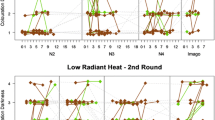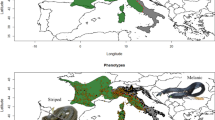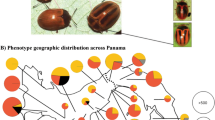Abstract
Melanism in moths is the phenomenon in which some individuals of a species are darker than the typical form, due to an increased deposition of melanin in their epidermal scales. For over a century this has received much attention from entomologists and more recently geneticists. In Britain early attempts to account for the occurrence of melanism in many different ecological situations stressed the importance of environmental factors acting directly. For example, White (1876) cites climatic factors as being the ‘exciting cause’ of melanism in the Highlands of Scotland. Tutt (1890, 1891) began by having similar views, correlating melanism with high rainfall and humidity. Later (1899) his emphasis changed and he argued that climatic factors were an indirect cause of melanism; in areas of high rainfall, particularly where smoke was also present in the atmosphere (e.g. Lancashire and Yorkshire) such surfaces as rocks and trees were darkened by the action of rain, or rain and soot. On such surfaces melanic moths were better concealed and ‘natural selection’ augmented by ‘hereditary tendency’ favoured these forms.
Access this chapter
Tax calculation will be finalised at checkout
Purchases are for personal use only
Preview
Unable to display preview. Download preview PDF.
Similar content being viewed by others
References
Barrett C. G. (1901) The Lepidoptera of the British Islands. Vol. 7, pp. 135–139 London, Lovell Reeve.
Clarke C. A. & Sheppard P. M. (1964) Genetic control of the melanic form insularia of the moth Biston betularia L. Nature 202, 215–216.
Clarke C. A. & Sheppard P. M. (1966) A local survey of the distribution of industrial melanic forms in the moth Biston betularia and estimates of the selective values of these in an industrial environment. Proc. R. Soc, B 165, 424–439.
Creed E. R. (1966) Geographic variation in the Two-spot Ladybird in England and Wales. Heredity 21, 57–72.
Cott H. B. (1940) Adaptive coloration in animals. Methuen, London.
Edelston R. S. (1864) Entomologist 2, 150.
Fisher R.A. (1933) On the evidence against the chemical induction of melanism in Lepidoptera. Proc. R. Soc, B 112, 407–416.
Ford E. B. (1937) Problems of heredity in the Lepidoptera. Biol. Rev. 12, 461–503.
Ford E. B. (1940) Genetic research in the Lepidoptera. Ann. Eugen., Lond. 10, 227–252.
Gilbert O. L. (1965) Lichens as indicators of air pollution in the Tyne valley. In G.T. Goodman, R.W. Edwards and J. M. Lambert (eds.). Ecology and the Industrial Society, pp. 35–47. Blackwell Scientific Publications, Oxford.
Gilbert O. L. (1968) Bryophytes as indicators of air pollution in the Tyne valley. New Phytol. 67, 15–30.
Harrison J. W. H. (1920) Genetical studies in the moths of the geometrid genus Oporabia (Oporinia) with a special consideration of melanism in the Lepidoptera. J. Genet. 9, 195–280.
Harrison J.W. H. (1935) The experimental induction of melanism and other effects in the geometrid moth, Selenia bilunaria Esp., Proc. R. Soc. B. 117, 78–92.
Kettlewell H. B. D. (1955a) Selection experiments on industrial melanism in the Lepidoptera. Heredity 9, 323–342.
Kettlewell H. B. D. (1955b) Recognition of the appropriate backgrounds by pale and black phases of Lepidoptera. Nature 175, 943.
Kettlewell H. B. D. (1956) Further selection experiments on industrial melanism in the Lepidoptera. Heredity 10, 287–301.
Kettlewell H. B. D. (1957) Industrial melanism in the Lepidoptera and its contribution to our knowledge of evolution. Proc. R. Instn. Gt. Br. 36, 1–14.
Kettlewell H. B. D. (1958a) A survey of the frequencies of Biston betularia (L.) Lep. and its melanic forms in Great Britain. Heredity 12, 51–72.
Kettlewell H. B. D. (1958b) Industrial melanism in the Lepidoptera and its contribution to our knowledge of evolution. Proc. ioth Int. Congr. Ent. (1956) 2, 831–841.
Kettlewell H. B. D. (1959) New aspects of the genetic control of industrial melanism in the Lepidoptera. Nature 183, 918–921.
Kettlewell H. B. D. (1961) The phenomenon of industrial melanism in the Lepidoptera. A. Rev. Ent. 6, 245–262.
Kettlewell H. B. D. (1965) A twelve-year survey of the frequencies of Bistort betularia (L.), and its melanic forms in Great Britain. Ent. Rec. 77, 195–218.
Kettlewell H. B. D. & Berry K. J. (1961) The study of a cline. Heredity 16, 403–414.
Kettlewell H. B. D. & Berry R. J. (1969) Gene flow in a cline. Heredity 24, 1–14.
Kettlewell H. B. D., Berry R. J., Cadbury C. J. & Phillips C. C. (1969) Differences in behaviour, dominance and survival within a cline. Heredity 24, 15–25.
Lees D. R. (1968) Genetic control of the melanic form insularia of the Peppered Moth Bistort betularia (L.). Nature 220, 1249–1250.
Ministry of Technology (1964–69) Warren Spring Laboratory, ‘The investigation of air pollution’. National Survey Annual Summaries, Warren Spring Laboratory.
Sargent T. D. (1966) Background selections of geometrid and noctuid moths. Science 154, 1674–1675.
Sargent T. D. (1969) Background selections of the pale and melanic forms of the cryptic moth Phigalia titea (Cramer). Nature 222, 585–586.
Skye E. (1968) Lichens and air pollution. Actaphytogeogr. suec. 52, 1–123.
Thomsen M. & Lemche H. (1933) Experimente zur Erzeilung eines erblichen melanismus bei dem Spanner Selenia bilunaria Esp. Biol. Zbl. 53, 541–560.
Tutt J.W. (1890) Melanism and melanochroism in British Lepidoptera. Ent. Rec. 1, 5–325.
Tutt J.W. (1891) Melanism and melanochroism in British Lepidoptera. Ent. Rec. 2, 3–149.
Tutt J.W. (1899) A natural history of the British Lepidoptera. Vol. I, pp. 63–66, Swann Sonnenschein, London.
White D. F. B. (1876) On melanochroism and leucochroism. Entomologist’s mon. Mag., 13, 172–179.
Editor information
Editors and Affiliations
Rights and permissions
Copyright information
© 1971 Blackwell Scientific Publications
About this chapter
Cite this chapter
Lees, D.R. (1971). The Distribution of Melanism in the Pale Brindled Beauty Moth, Phigalia pedaria, in Great Britain. In: Creed, R. (eds) Ecological Genetics and Evolution. Springer, New York, NY. https://doi.org/10.1007/978-1-4757-0432-7_8
Download citation
DOI: https://doi.org/10.1007/978-1-4757-0432-7_8
Publisher Name: Springer, New York, NY
Print ISBN: 978-1-4757-0434-1
Online ISBN: 978-1-4757-0432-7
eBook Packages: Springer Book Archive




